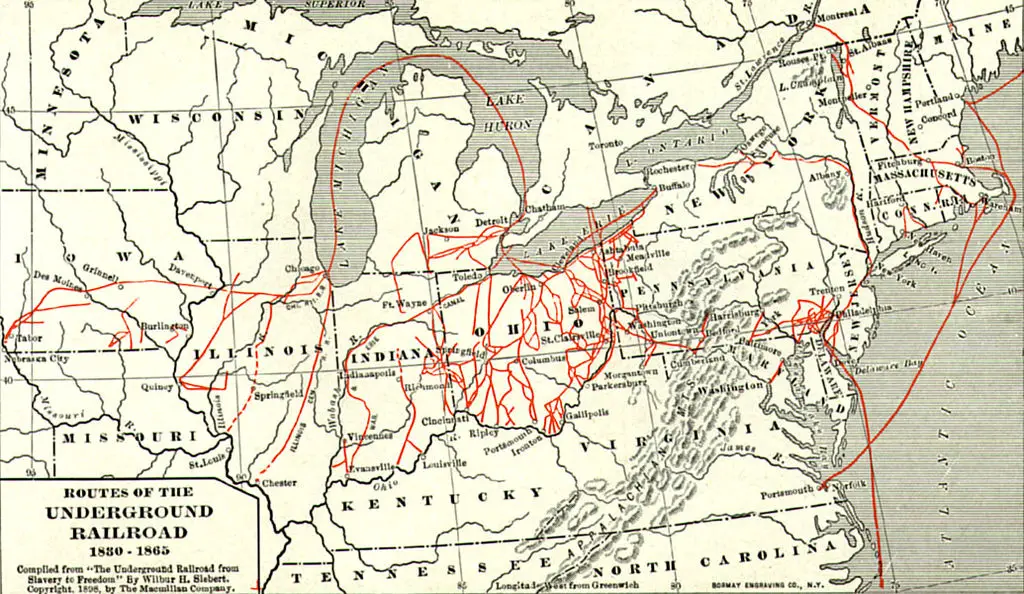The Underground Railroad
The “Underground Railroad” was a network established by those that believed in freedom for the Black slaves between 1810 and the 1860s.
These were homes, shelters hideouts, and people that reached from the southern states where slavery was popular, all the way to the northern states and then into Canada.

The name might say “railroad,” this wasn’t a railroad such as the ones used by trains. Instead, these were secret ways to get slaves to freedom and they chose the name because they transported people.
The word “underground” is believed to have been used because everything was done in secret.
- Those involved in the Underground Railroad had titles for the jobs that they did. They took the names from the actual railways. Conductors were people that led the slaves that were escaping along the routes. The places that the slaves were hidden as they moved from south to north were called depots or stations. There were many people that had money that they donated for food and travel for the slaves and these people were called stockholders. Escaping slaves were often called cargo or passengers.
- The network that was created was made by a lot of the white people that were against slavery. These people were part of the abolitionist movement. The Quakers were a religious group that were antislavery and many of the homes and shelters were provided by Quakers. Some of the people that worked on the Underground Railroad were also former slaves that had escaped. One of the most notable was Harriet Tubman who returned to continue to help others escape. One of the famous Quaker heroes of the time was Levi Coffman who was said to have helped over 3,000 slaves escape.
- The process of moving slaves to freedom wasn’t easy. The slaves would have to travel at night and were moved from one station to another one. Since stations could be as much as ten to twenty miles apart, it meant that they would walk this distance at night and then stay until it was safe to leave again.
- Not only were the slaves in danger, but it was against the law for anyone to help them escape. The southern states wanted to keep slavery and if they caught any of the conductors they would put them to death by hanging them. Southerners knew about Harriet Tubman and put a price of $40,000 on her head for capture. Even famous men such as George Washington complained about the Underground Railroad when one of his slaves escaped by using it.
- Since the entire process of the Underground Railroad was based on secrecy, it’s unknown exactly how many slaves were successful in using it to get to freedom. Some historians guess that as nay as 100,000 slaves may have escaped during the entire time that the Underground Railroad was used.
- At one time the escaped slaves could reach the northern states and feel comfortable that they were free. However, Congress passed the Fugitive Slave Act in 1850 and this required escaped slaves to be returned to their owners. This meant that now slaves had to be smuggled into Canada where they were guaranteed their freedom and the new law wouldn’t affect them. The slaves called Canada “The Promised Land” and to get there they used the Mississippi River that they called the “River Jordan.” Both of these names originated from Biblical stories.
- Not all slaves made the choice to go from the southern states to the north. In some cases they escaped to Mexico or to the very south in Florida.
Q&A:
Why was the escape route called the “Underground Railroad?”
Underground for secrecy and railroad because they transported people
How many slaves do historians guess used the Underground Railroad to get to freedom?
100,000
What was the price that southerners put on Harriet Tubman’s head for capture?
$40,000
What was the name of the law that Congress passed in 1850 that required all slaves to be returned to their owners?
The Fugitive Act
What Biblical name did slaves call Canada?
The Promised Land
What was the name that they called people that led slaves on their routes in the Underground Railroad?
Conductors



